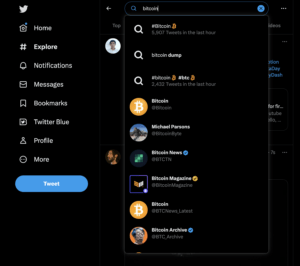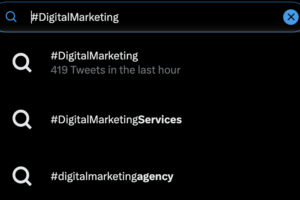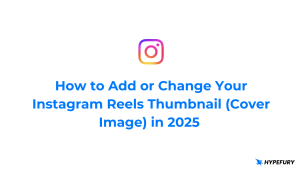You may feel that hashtags are a thing of the past, but they remain crucial to any smart Twitter presence.
Twitter hashtags are a way to categorize tweets and make them more discoverable to users who are interested in certain specific topics. A hashtag is a word or phrase preceded by the pound sign (#), for instance as #marketing or #MondayMotivation.
On Twitter, when a user clicks on a hashtag, they can see all the tweets that include that same hashtag, regardless of whether they follow the user who tweeted it.
Using hashtags on Twitter can be a powerful tool for increasing your visibility, engaging with your audience and driving traffic to your website or other social media profiles. When you use relevant hashtags in your tweets, you increase the chances that your content will be seen by people who are interested in the same topics.
By participating in conversations around popular Twitter hashtags, you can also connect with other users yourself, build your following and establish your brand as an authority in your industry or niche.
Table of content
- Different types of Twitter hashtags
- How to use Twitter hashtags effectively
- How to find the Twitter hashtags to use
- Create your own Twitter hashtag
- Monitor and analyze Twitter hashtag performance
Different types of Twitter hashtags
Different types of Twitter hashtags can be used for different purposes, from increasing brand awareness, promoting your campaigns or events, and engaging with current trends and news. It’s therefore important for you to understand the right type of hashtag you should use to develop the most effective strategy to suit your need. Here’s a breakdown to help you!
Brand hashtags
HAPPY WEEKEND! 🥳 Sending positive 💛 fun 🌈 energy 💥 your way ✨ Have a great day, everyone 🙌🏽 #CultureHouse #DC #Dance #TikTokTrend #Collide #OOTD #Nike #JustDoIt pic.twitter.com/9aUbAnQgAe
— Sierra Fox (@thesierrafox) February 10, 2023
Brand hashtags are unique to your brand and are used to make the brand more popular and increase engagement on Twitter. Some popular examples of brand hashtags include Nike’s #justdoit, Coca-Cola’s #shareacoke and Red Bull’s #givesyouwings. By using a branded hashtag in your tweets, you can encourage your followers and other users who see your tweets to engage with you and your brand and share your content with their own followers. And it makes your brand more legit!
Campaign hashtags
What Are the Warning Signs of Heart Attacks in Women? #GoRedForWomen pic.twitter.com/XMiPm92f8l
— Dr. Jen Caudle (@DrJenCaudle) February 3, 2023
Campaign hashtags, as the name suggests, are used to promote a specific campaign or initiative on Twitter. These hashtags can be used for a short or a longer amount of time depending on the campaign. They are typically used to increase engagement and awareness around a specific cause or event. Some examples are the American Heart Association’s #GoRedforWomen, Starbucks’ #RedCupContest, and the World Wildlife Fund’s #EarthHour.
Event hashtags
Join Academy Award-nominated actor and producer @RobertDowneyJr for a riveting discussion about online crime with three of the industry’s most knowledgeable minds at #SXSW2023.
— SXSW (@sxsw) February 21, 2023
Event hashtags are used to promote and engage with events on Twitter. These can be anything: conferences, concerts, festivals or an initiative you are yourself running. These hashtags, naturally, usually don’t last very long and are used to gather attention around the event when it is first announced, as it unfolds, and perhaps shortly after it’s over when people reflect on their experience with it. Festivals, for instance, will use event hashtags such as #SXSW2023 for the 2023 edition of the South by South West festival, #Coachella2023, or #NYFW for the New York Fashion Week.
Trending hashtags
AFTERSUN, the apartment of the grown-up Sophie reshaping into reminiscence #PaulMescal #Oscars2023 @mubi #AftersunMovie pic.twitter.com/GDNXTJJJ1H
— Floor Plan Croissant (@FPlanCroissant) January 26, 2023
Trending hashtags are hashtags that are currently popular on Twitter, either worldwide or in your specific geographic location. These hashtags are determined by Twitter’s algorithm and usually relate to current events, holidays, popular culture or whatever people are currently tweeting about. By using a trending hashtag in your tweet, you can increase your visibility and potentially reach a wider audience just as they are busy talking about that specific topic.
How to use Twitter hashtags effectively
Use relevant hashtags
It’s important that you choose hashtags that are relevant to you or your brand!
Choosing Twitter hashtags just because they are trendy won’t make your tweets more popular if they have nothing to do with the hashtags you use. You’d actually look pretty silly!
The aim of using relevant hashtags is to increase the visibility of your brand on Twitter to hopefully reach a wider audience and potentially gain new followers who are interested in topics related to your brand.
To use relevant Twitter hashtags effectively, start by identifying the keywords and phrases that are relevant to your brand and the content of your tweet. For example, if you are a restaurant sharing a photo of a new dish you just added to the menu, you might use hashtags like #foodie, #foodporn and #newdish.
Teriyaki chicken & tempura for lunch at work 😎 #foodie #teriyakichicken pic.twitter.com/Ypx0NJIS8S
— Mr Home Chef 🇺🇸 🔪🍽️ (@mrhomechef85) February 10, 2023
Use a mix of popular and niche hashtags
It makes sense that including popular hashtags in your tweets can help increase your reach and visibility on Twitter: a hashtag is popular because many people are using it, so when you use it, your content becomes searchable by anyone who is interested in that particular topic or keyword, which can help you gain new followers and increase engagement.
However, this can be a double-edged sword: keep in mind that using only popular Twitter hashtags can also make it harder for your content to stand out among the competition. Again, the hashtag is popular because a lot of people are using it, and your tweet will be one more amongst many!
This is where niche hashtags can help.
Using niche Twitter hashtags allows you to target a more specific audience and make it easier for users who are interested in your specific niche to find your content. When you use a niche hashtag, you are more likely to reach people who are specifically interested in your industry, topic or product, which can lead to more meaningful engagement and a higher conversion rate.
Using niche hashtags can also help you establish your brand as an authority in your niche and attract followers who are genuinely interested in what you have to offer.
In a way, using niche hashtags is a way to cut straight to the point and reach your ideal audience directly.
Still, it’s important to strike a balance between using popular and niche hashtags in your tweets. Including too many popular hashtags can make it difficult for your content to stand out, while using too many niche hashtags can make it hard for your content to be discovered by new users.
Make sure you take into account all these elements to make the right choice of hashtag for every tweet !
Don’t use too many hashtags
While using hashtags can be effective in increasing your visibility on Twitter, using too many can make your tweet look spammy and reduce engagement. You’d look like a try-hard! A good rule of thumb is to use no more than two or three hashtags per tweet.
Put hashtags at the end of your tweet
The point of every tweet should always be the original text you write in it, so make sure to put your chosen hashtags at the end of your tweet to make it easier for people to read and engage with what you have to say.
Doing so also ensures that your tweet looks clean and professional, and not like a desperate attempt to be seen!
The wonderful Liam 😊 One of the many amazing pianists in tonight's episode of The Piano. Tune into @Channel4 at 9pm GMT 🎹 #ThePiano pic.twitter.com/BdNaMxH4hL
— Lang Lang (@lang_lang) February 22, 2023
Participate in trending conversations
Joining conversations around trending Twitter hashtags can help increase your visibility and meet other users on Twitter who are interested in the same topic. Make sure to use the trending hashtag in your tweet to ensure that it’s seen by the people following that hashtag!
BREAKING: the Fed has started hiring CBDC software devs to try to compete with #bitcoin pic.twitter.com/c9DNyVDW2y
— Pierre Rochard (@BitcoinPierre) February 19, 2023
Use hashtags in your Twitter bio
Hashtags are not just for tweets.
Using them in your Twitter bio can help increase your visibility and help people find your profile when they search for specific hashtags related to what you do and what you’re all about.
How to find the Twitter hashtags to use
Hashtags need to fit your needs, but how do
Here are a few tips to help you pick the best hashtags for your purposes.
Use Twitter’s search function
Twitter’s search function is a great place to start when looking for popular hashtags in your industry. Simply type in a keyword related to your industry, and Twitter will suggest related hashtags that you can use in your tweets. It’s that easy!
Look at your competitors
You can always learn from your competition! Take a look at your competitors’ Twitter profiles and see what hashtags they are using in their own tweets.
This can give you an idea of which hashtags are popular in your industry, as well as help you discover new ones that you may not have thought of yourself. It can be a source of inspiration!
Use hashtag research tools
In addition to Twitter’s native search function, there are many tools available online that can help you research popular hashtags in your industry or niche. Some popular ones include Hashtagify, RiteTag, and Keyhole. These tools can show you the popularity of specific hashtags, suggest related hashtags, and even provide you with analytics on the performance of a hashtag.
Participate in Twitter chats
Twitter chats are, simply, conversations that take place on Twitter around a specific topic and using a specific hashtag. By participating in Twitter chats related to your industry or what interests you, you can discover new Twitter hashtags and connect with other users in that same corner of the internet.
Follow thought leaders in your industry
It’s always a good idea to try and learn from the best, so follow thought leaders and experts in your industry on Twitter! See what hashtags they are using in their tweets and how they respond to the latest trends in your industry with them. That way, you can stay up to date and ensure that your tweets are seen by the right people!
Create your own Twitter hashtag
You don’t have to always jump on a band waggon – you can drive your own!
Creating a branded hashtag – meaning, a hashtag just for your own brand to represent it and to be used in your own tweets – is a great way to better establish and showcase your brand or product and encourage user engagement on Twitter.
But think before you tweet! To create an effective branded hashtag, start by brainstorming keywords and phrases that are relevant to what you have to offer and that your target audience might be searching for on Twitter. Keep in mind that your branded hashtag should be short and easy to remember!
Your hashtag needs to be original and unique to your brand – you don’t want it to be already associated with another brand or campaign!
Once you have a list of potential Twitter hashtags, do some research to make sure they haven’t already been used by other brands or for other purposes. You don’t want to create confusion!
Done all that? Great! You now have your own branded hashtag. All is left to do now is to start using it.
Make sure to be consistent with your hashtag – just as for many other aspects of social media, consistency is key.
Encourage your followers to use your branded hashtag as well by including it in your social media profiles, website and other marketing materials! You can even run a Twitter contest or promotion that requires participants to use your branded hashtag in their tweets.
By using a branded hashtag in these smart ways, you can increase your brand awareness and encourage people to engage with your content on Twitter. Plus, it makes it easy for users to find all of your tweets and join the conversation around your brand.
Monitor and analyze Twitter hashtag performance
Data is your friend! You can learn a lot from it, if you are open to its teachings.
It’s important to make data-driven decisions and keep adjusting your strategy to hit your target by monitoring and analyzing the performance of your Twitter hashtags.
You can track your hashtag mentions by using Twitter’s built-in analytics tools or a third-party analytics tool, which will also allows you to monitor the number of times your hashtag has been mentioned on Twitter.
Having an understanding of the popularity and reach of your hashtag can really help you! Plus, looking at this data could also be an effective way to identify which users or brands are using the Twitter hashtags you are using, as you can learn about the demographics of your users.
You should also pay attention to the engagement you get from your audience – how many likes, retweets and replies your tweets using your hashtags receive.
Use sentiment analysis to understand how users are interacting and reacting to your hashtag on Twitter to better identify areas of your strategy to improve. If a hashtag tends to create negative responses, it may be time to switch things up!
If you do all of the above and track your performance over time to identify whether your tweets are gaining or losing popularity, you will be able to adapt to changing trends and audience preferences and you’ll be sure to be always ready to make the changes needed for you to remain relevant in the discourse!
Now that you know the power and subtleties of using Twitter hashtags, it’s your turn to make the most of them in your Twitter marketing strategy!







